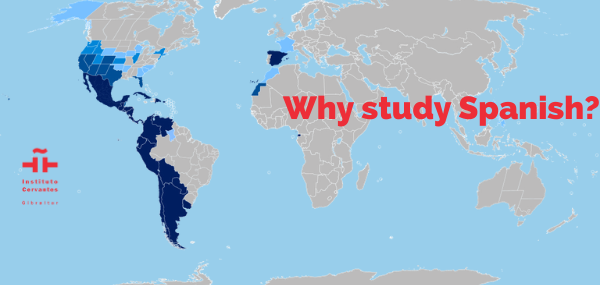
We would like to thank you for choosing to learn a language spoken by 570 million people across the world.
Below are just a few reasons to encourage you to continue your Spanish language-learning journey!
Our friends at the British Council have shown in their reports that, when British students decide to embark on the adventure that is learning a foreign language, Spanish is their first choice. In fact, in the United Kingdom, Spanish is perceived to be the most important language for the future.
In its report “Languages for the Future”, the British Council notes that an increasing number of British and American companies view candidates more positively if they speak and understand Spanish.
And for a good reason: Spanish is a living language which is very much active in international business, diplomacy and international relations.
It is an official language of a wide range of international organisations such as the United Nations, the International Criminal Court, the World Trade Organisation, the International Labour Organisation, the International Telecommunication Union, the Ibero-American General Secretariat, the Latin Union, the African Union, the Central American Common Market, the European Union, Mercosur, the North American Free Trade Agreement (NAFTA), the Organisation for Safety and Cooperation in Europe, the Organisation of American States and the Union of South American Nations.
It is also the official language of a large number of countries and is used on an everyday basis in many areas across the world. Currently, Mexico is the country with the most Spanish speakers (127 million), followed by the United States, with over 50 million native Spanish speakers. It is estimated that, by 2060, the United States will be home to the largest Spanish-speaking population in the world.
Demographic Reasons
- Nearly 483 million people speak Spanish as their mother tongue. (The 2018 Anuario del español calculated 480 native speakers).
- The number of potential users of Spanish exceeds 580 million. This figure groups together those with native proficiency, limited proficiency and students of Spanish as a foreign language. Last year it was 577 million.
- Spanish is the second most-spoken mother tongue in the world by number of speakers, only behind Mandarin.
- In the global language calculation of speakers (native proficiency + limited proficiency + Spanish students), it is ranked third, after English and Mandarin. 7.6% of the current world population speaks Spanish. This percentage is predicted to increase by a tenth (to 7.7%) by 2050.
- For demographic reasons, the percentage of the world’s population who speak Spanish as their mother tongue is increasing, whilst the proportion of Mandarin, English and French speakers is decreasing.
- By 2060, the United States will have the second-highest number of Spanish speakers in the world after Mexico: nearly one in every three Americans will be Hispanic.
Economic reasons
- Together, the Spanish-speaking countries contribute 6.9% of the world’s GDP (Gross Domestic Product). This is higher than the percentage generated by countries where French is the official language.
- In the case of Spanish, having a shared language quadruples the number of bilateral exports between Spanish-speaking countries.
- Spain is the world’s third most prominent exporter of books, after the United Kingdom and the United States.
- Two Spanish-speaking countries - Spain and Argentina - are amongst the world’s 15 top book producers, according to the International Publishers Association.
Reasons relating to online communication
- Spanish is the third most-used language on the Internet, after English and Mandarin.
- 8.1% of online communication is in Spanish.
- It is the second most widely-used language on Wikipedia, Facebook, Twitter and LinkedIn. Of the 580 million users of the social network LinkedIn, 55 million use Spanish to a greater or lesser extent. Most of these (43 million) are in Central and South America.
- Spanish has great potential for growth on the Internet since, on average, 65.8% of the population in Spanish-speaking countries has internet access (far behind Spain, where this figure exceeds 92%).
- Mexico is one of the top 10 countries in terms of internet user numbers.
More reasons to learn Spanish as a foreign language:
- A total of 21,882,448 students are currently learning Spanish as a foreign language (67,000 more than last year), according to data gathered from 110 countries and from all teaching levels.
- The Instituto Cervantes estimates that the real demand is 25% higher, since this data barely reflects private teaching.
- In the USA, Spanish is the most-studied language at all levels of education. In the United Kingdom, Spanish is perceived as the most important language for the future.
- In the European Union, France, Italy, the United Kingdom and Spain (in that order) are the countries with the highest number of Spanish students.
- Teaching of Spanish in English-speaking countries such as Canada (90,000 students), Ireland (47,000), Australia (34,000) and New Zealand (36,000) has also significantly increased.
